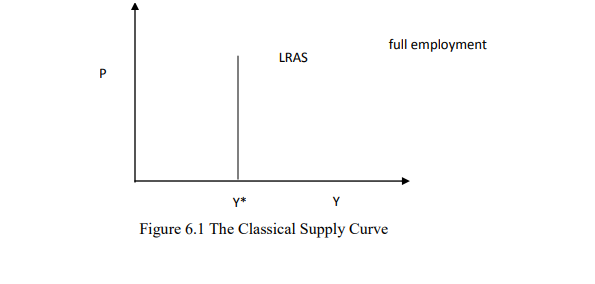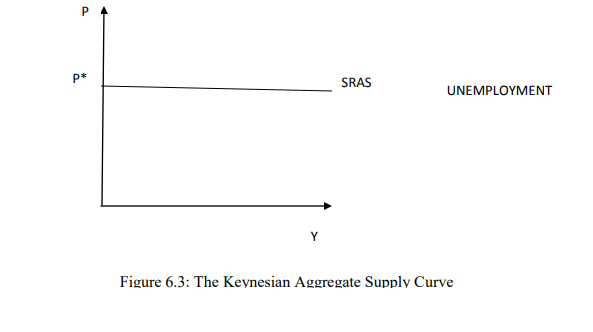6.1 Definition of aggregate supply (AS)
The aggregate supply curve describes; for each given price level, the quantity of output firms are willing to supply. in the shot run the AS curve is horizontal (the Keynesian aggregate supply curve); in the run the AS is vertical (the classical supply curve).
6.2 The Classical Supply Curve
The classical supply curve is vertical indicating that the same amount of goods will be supplied whatever the price level. It is based on the assumption that the labour market is in equilibrium with full employment of the labour force. We call the level of output corresponding to full employment of the labour force potential GDP,Y*. It grows over time as the economy accumulates resources and as technology improves, so the position of the classical aggregate supply curve moves to the right over time

6.3 The Keynesian Aggregate Supply Curve
It is horizontal; indicating that firm‘s will supply whatever amount of goods is demanded at the existing price level. The idea underlying the Keynesian aggregate supply curve is that because there is unemployment firm‘s can obtain as much labour as they want at the current wage. Their average costs of production therefore are assumed not to change as their output level changes.
They are accordingly willing to supply as much as is demanded at the existing price level. This is an existence situation in which all prices are fixed. Our task now is to refine this understanding of short – run aggregate supply. Unfortunately, one fact makes this task more difficult; economists disagree about how best to explain aggregate supply.

As a result this section begins by presenting the four prominent models of the short-run aggregate supply curve. Although these models differ in some significant details, they are also related in an important way: they share a common theme about what makes the short-run and long-un aggregate supply curve differ and a common conclusion that the short-run aggregate supply curve is upward sloping.
6.4 Models of Aggregate Supply in the Short Run
In all the models, some market imperfection cause the output of the economy to deviate from the classical benchmark. As a result, the short-run aggregate supply curve is upward sloping, rather than vertical, and shifts in the aggregate demand curve cause the level of output to deviate temporarily from the natural rate. These temporary deviations represent the booms and busts of the business cycle. Although each of the four models tasks us down a different theoretical route, each route ends up in the same place. That final destination is a short -run aggregate supply curve equation of the form.
Y =Y* +a(P-Pe ) , a>0
Where Y is out put, Y* is the natural rate of output, P is the price level and Pe is the expected price level. This equation states that output deviates from its natural rate when the price level deviates from the expected price level. The parameter K indicates how much of output responds to unexpected changes in the price level. 1/ a id the slope of the aggregate supply curve.
The aggregate supply curve shows the relationship between the price level output. While the long run aggregate supply curve is vertical, the short run aggregate supply curve is upward sloping. There are four major models that explain why the short-term aggregate supply curve slopes upward. The first is the sticky-wage model. The second is the worker misperception model. The third is the imperfect – information model. The fourth is the sticky-price model. The following headings explain each of these models in depth. As we move on to explore each of these four models, keep in mind that an upward sloping short run aggregate supply curve means that as the price level rises, output increases. This is the point of each of the following models.
6.5 Sticky -Wage Model
The sticky-wage model of the upward sloping run aggregate supply curve is based on the labour market. In many industries, short run wages are set by contracts. that is, workers are paid based on relatively permanent pay schedules that are decided upon by management or unions or both. When the economy changes, the wage the workers receive cannot adjust immediately. Given tat wages are sticky; the chain of events leading from an increase in the price level to an increase in output is fairly straightforward. The price level rises, the normal wage remains fixed because this is solely based on the dollar amount of the wage. The real wage, on the other hand, falls because this is based on the purchasing power of the wage. A higher price level means that a given wage is able to purchase fewer goods and services.
When the real wage that firms pay employees falls, labour becomes cheaper. however, since the amount of output produced for each unit of labour is still the same, firms choose to hire more workers and increase revenues and profits. When firms choose to hire labour, output increases. Thus, when the price level rises, output increases because of sticky wages. Let‘s summarize the chain of events that leads from an increase in the price level to an increase in output in the sticky-wage model. When the price level rises, real wages fall. When real wages fall, labour becomes cheaper. When labour becomes cheaper, firms hire more labour. When firms hire more labour, output increases.
6.6 Worker Misperception Model
The worker – misperception model of the upward sloping short-run aggregate supply curve is again based on the labour market. This time, unlike in the sticky -wage model, wages are free to move as the economy changes. The amount of work that an employee is willing to supply is based on the expected real wage. That is, workers know how many dollars they are being paid, the nominal wage, but workers can only guess at how much goods and services they can purchase with this wage, the real wage. In general, the higher the real wage the more work the workers are willing to supply.
Now let‘s say that the price level increases because we assume that firms have more information than workers do, firms will give workers a raise so that their nominal wage increases with the price level. But since the workers do not realize that the price level increased, they will believe that their real wage increased, not just their nominal wage. At a higher real wage, workers are induced to work more. When workers work more, output increases. Thus, when the price level increases output also increases because of worker – misperception.
Let‘s summarize the chain of events that leads from an increase in the price level to an increase in output in the worker-misperception model. When the price level rises, firms increase nominal wages. When nominal wages increase, workers-due to misperceptions- believe that real wages also increase. When workers believe that real wages increase, workers provide more labour. When workers provide more labour, output increases.
6.7 Imperfect-Information Model
The imperfect-information model of the upward sloping short-run aggregate supply curve is again based on the labor market. In this model, unlike either the sticky- wage model or the worker-misperception model, neither the worker nor the firm has complete information. That is neither is better informed than the other is about the real wage, the nominal wage, or the price level. In this model, producers are considered to be really only aware of the price of the goods and services that they produce. That is, producers are unable to recognize overall increases in the price level because they focused on their products only. Instead, producers only recognize changes in the prices of the goods and services that they produce. Given that producers are unable to recognize changes in the overall price level, they are likely to confuse changes in the overall price level (absolute changes in the price level).
It is important to understand the implications of both relative changes in the price level and absolute changes in the price level. When a relative change in the price level occurs, producers of some goods and services are better off because the price of their output increases to a greater extent than the overall price level.
Both the real wage and nominal wage earned by these producers increase. When an absolute change in the price level occurs, all producers are affected equally and the nominal wage increases while the real wage remains constant. Recall that producers are willing to provide more labor when the wage is high. That is, they will work harder when they are getting paid more for their work. Also recall that producers cannot differentiate between relative changes in the price level and absolute changes in the price level. Thus, when a producer sees a change in the price level, she will likely believe that it is a relative change in the price level, even if it is an absolute change in the price level. Because of this, the producer will work more and produce more output when the price level rises. Thus, an increase in the price level causes output to rise.
Let‘s summarize the chain of events that leads from an increase in the price level to an increase in output in the imperfect – information model. When the overall price level rises, producers mistake it for a relative increase in the price level. When the relative price level rises, the real wage earned by producers rises. When the real wage earned by producers rises the amount of labour supplied by producers increases. When the amount of labour supplied by producers increases, output increases.
6.8 Sticky -Price Model
The sticky-price model of the upward sloping short-run aggregate supply curve is based on the idea that firms do not adjust their price instantly to changes in the economy. There are numerous reasons for this. First, many prices, like wages, are set in relatively long-term contracts. Imagine if your wage at work place changed every day as the economy changed. Firms hold prices sable from distracting their regular customers Firms hold their prices stable of middleman costs When firms prepare to set their prices .they take into account the expected price level .when the expected price level is higher, firms set prices higher to compensate for the higher price of
inputs. When the price charged for input is higher firms produce more output as the incentive for production is also higher. Therefore, an increase in the price level leads rather directly to an increase in output in the sticky price model
Another way to conceptualize the relationship between the price level and output in the sticky price model .when the level of output is high the demand fro goods and services is also high. therefore when firms set their sticky price they set them high to account for high demand .When firms set their prices high ,the overall price level increases and a high level of output leads to a high level of demand which leads to a high price level
